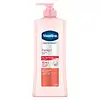What's inside
What's inside
 Key Ingredients
Key Ingredients

 Benefits
Benefits

 Concerns
Concerns

 Ingredients Side-by-side
Ingredients Side-by-side

Water
Skin ConditioningStearic Acid
CleansingIsopropyl Palmitate
EmollientParaffinum Liquidum
EmollientGlycerin
HumectantGlyceryl Stearate
EmollientEthylhexyl Methoxycinnamate
UV AbsorberNiacinamide
SmoothingDimethicone
EmollientButyl Methoxydibenzoylmethane
UV AbsorberParfum
MaskingCarbomer
Emulsion StabilisingPetrolatum
EmollientCetyl Alcohol
EmollientTitanium Dioxide
Cosmetic ColorantSodium Ascorbyl Phosphate
AntioxidantHydrated Silica
AbrasiveTocopheryl Acetate
AntioxidantIsomerized Linoleic Acid
Skin ConditioningHelianthus Annuus Seed Oil
EmollientRetinyl Palmitate
Skin ConditioningLactic Acid
BufferingPotassium Lactate
BufferingAluminum Hydroxide
EmollientAlginic Acid
Skin ConditioningTriethanolamine
BufferingDisodium EDTA
Phenoxyethanol
PreservativeMethylparaben
PreservativePropylparaben
PreservativeBHT
AntioxidantCI 17200
Cosmetic ColorantWater, Stearic Acid, Isopropyl Palmitate, Paraffinum Liquidum, Glycerin, Glyceryl Stearate, Ethylhexyl Methoxycinnamate, Niacinamide, Dimethicone, Butyl Methoxydibenzoylmethane, Parfum, Carbomer, Petrolatum, Cetyl Alcohol, Titanium Dioxide, Sodium Ascorbyl Phosphate, Hydrated Silica, Tocopheryl Acetate, Isomerized Linoleic Acid, Helianthus Annuus Seed Oil, Retinyl Palmitate, Lactic Acid, Potassium Lactate, Aluminum Hydroxide, Alginic Acid, Triethanolamine, Disodium EDTA, Phenoxyethanol, Methylparaben, Propylparaben, BHT, CI 17200
Water
Skin ConditioningDicaprylyl Maleate
EmollientC12-15 Alkyl Benzoate
AntimicrobialButylene Glycol
HumectantGlycerin
HumectantSorbitan Stearate
EmulsifyingSqualane
EmollientStearic Acid
CleansingRetinol
Skin ConditioningCaprylic/Capric Triglyceride
MaskingUrea
BufferingYeast Amino Acids
HumectantTrehalose
HumectantInositol
HumectantTaurine
BufferingBetaine
HumectantArnica Montana Flower Extract
MaskingEpilobium Angustifolium Flower/Leaf/Stem Extract
Skin ConditioningHydrolyzed Soy Flour
Skin ConditioningSpiraea Ulmaria Extract
AstringentHoney Extract
HumectantCetearyl Alcohol
EmollientCeteareth-20
CleansingTalc
AbrasiveGlycolipids
Skin ConditioningSodium Hyaluronate
HumectantPanthenol
Skin ConditioningLecithin
EmollientAvena Sativa Kernel Protein
Skin ConditioningTocopherol
AntioxidantMagnesium Ascorbyl Phosphate
AntioxidantChondrus Crispus Extract
Skin ConditioningDimethicone
EmollientSodium PCA
HumectantAllantoin
Skin ConditioningSclerotium Gum
Emulsion StabilisingCarbomer
Emulsion StabilisingDisodium EDTA
Aminomethyl Propanol
BufferingPhenoxyethanol
PreservativeCaprylyl Glycol
EmollientChlorphenesin
AntimicrobialCitrus Aurantium Dulcis Fruit Extract
MaskingWater, Dicaprylyl Maleate, C12-15 Alkyl Benzoate, Butylene Glycol, Glycerin, Sorbitan Stearate, Squalane, Stearic Acid, Retinol, Caprylic/Capric Triglyceride, Urea, Yeast Amino Acids, Trehalose, Inositol, Taurine, Betaine, Arnica Montana Flower Extract, Epilobium Angustifolium Flower/Leaf/Stem Extract, Hydrolyzed Soy Flour, Spiraea Ulmaria Extract, Honey Extract, Cetearyl Alcohol, Ceteareth-20, Talc, Glycolipids, Sodium Hyaluronate, Panthenol, Lecithin, Avena Sativa Kernel Protein, Tocopherol, Magnesium Ascorbyl Phosphate, Chondrus Crispus Extract, Dimethicone, Sodium PCA, Allantoin, Sclerotium Gum, Carbomer, Disodium EDTA, Aminomethyl Propanol, Phenoxyethanol, Caprylyl Glycol, Chlorphenesin, Citrus Aurantium Dulcis Fruit Extract
Ingredients Explained
These ingredients are found in both products.
Ingredients higher up in an ingredient list are typically present in a larger amount.
Carbomer is a polymer of acrylic acid. Its main role is to create a gel consistency.
A high amount of carbomer can cause pilling or balling up of products. Don't worry, most products contain 1% or less of carbomer.
Dimethicone is a type of synthetic silicone created from natural materials such as quartz.
What it does:
Dimethicone comes in different viscosities:
Depending on the viscosity, dimethicone has different properties.
Ingredients lists don't always show which type is used, so we recommend reaching out to the brand if you have questions about the viscosity.
This ingredient is unlikely to cause irritation because it does not get absorbed into skin. However, people with silicone allergies should be careful about using this ingredient.
Note: Dimethicone may contribute to pilling. This is because it is not oil or water soluble, so pilling may occur when layered with products. When mixed with heavy oils in a formula, the outcome is also quite greasy.
Learn more about DimethiconeDisodium EDTA plays a role in making products more stable by aiding other preservatives.
It is a chelating agent, meaning it neutralizes metal ions that may be found in a product.
Disodium EDTA is a salt of edetic acid and is found to be safe in cosmetic ingredients.
Learn more about Disodium EDTAGlycerin is already naturally found in your skin. It helps moisturize and protect your skin.
A study from 2016 found glycerin to be more effective as a humectant than AHAs and hyaluronic acid.
As a humectant, it helps the skin stay hydrated by pulling moisture to your skin. The low molecular weight of glycerin allows it to pull moisture into the deeper layers of your skin.
Hydrated skin improves your skin barrier; Your skin barrier helps protect against irritants and bacteria.
Glycerin has also been found to have antimicrobial and antiviral properties. Due to these properties, glycerin is often used in wound and burn treatments.
In cosmetics, glycerin is usually derived from plants such as soybean or palm. However, it can also be sourced from animals, such as tallow or animal fat.
This ingredient is organic, colorless, odorless, and non-toxic.
Glycerin is the name for this ingredient in American English. British English uses Glycerol/Glycerine.
Learn more about GlycerinPhenoxyethanol is a preservative that has germicide, antimicrobial, and aromatic properties. Studies show that phenoxyethanol can prevent microbial growth. By itself, it has a scent that is similar to that of a rose.
It's often used in formulations along with Caprylyl Glycol to preserve the shelf life of products.
Stearic Acid is a fatty acid. It is an emollient, emulsifier, and texture enhancer.
As an emollient, stearic acid helps soften skin. It aids the skin's protective barrier by preventing water loss. It also provides a gentle cleansing effect without stripping away natural oils.
Stearic acid may also be used to enhance the texture of products. It can add volume and stabilize ingredients such as water and oil. This can help water and oil ingredients from separating.
Sources of stearic acid include animal or vegetable fats/oils such as coconut or shea. It can be naturally found in butter, cocoa butter, shea butter, vegetable fats, and animal tallow.
This ingredient may not be Malassezia folliculitis, or fungal-acne safe.
Learn more about Stearic AcidWater. It's the most common cosmetic ingredient of all. You'll usually see it at the top of ingredient lists, meaning that it makes up the largest part of the product.
So why is it so popular? Water most often acts as a solvent - this means that it helps dissolve other ingredients into the formulation.
You'll also recognize water as that liquid we all need to stay alive. If you see this, drink a glass of water. Stay hydrated!
Learn more about Water